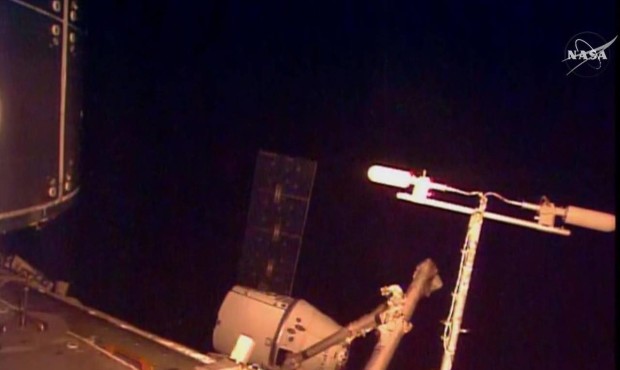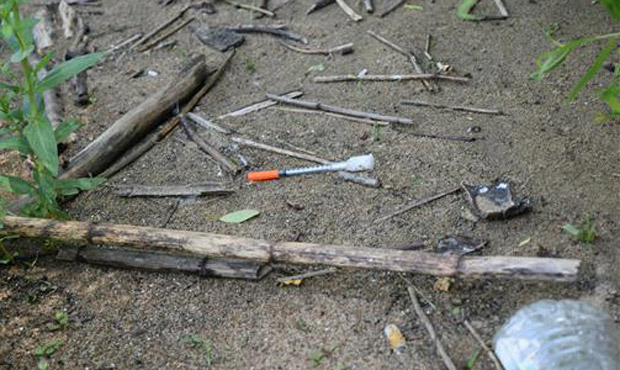AP
SpaceX delivers world’s 1st inflatable room for astronauts

In this frame taken from video from NASA TV, the SpaceX Dragon cargo ship is captured by a robot arm from the International Space Station, Sunday April 10, 2016. A SpaceX Dragon cargo ship arrived at the International Space Station on Sunday, two days after launching from Cape Canaveral, Florida. Station astronauts used a big robot arm to capture the Dragon, orbiting 260 miles above Earth. (NASA TV via AP)
CAPE CANAVERAL, Fla. (AP) — SpaceX has made good on a high-priority delivery: the world’s first inflatable room for astronauts.
A SpaceX Dragon cargo ship arrived at the International Space Station on Sunday, two days after launching from Cape Canaveral. Station astronauts used a robot arm to capture the Dragon, orbiting 250 miles above Earth.
The Dragon holds 7,000 pounds of freight, including the soft-sided compartment built by Bigelow Aerospace. The pioneering pod — packed tightly for launch — should swell to the size of a small bedroom once filled with air next month.
It will be attached to the space station this Saturday, but won’t be inflated until the end of May. The technology could change the way astronauts live in space: NASA envisions inflatable habitats in a couple decades at Mars, while Bigelow Aerospace aims to launch a pair of inflatable space stations in just four years for commercial lease.
For now, the Bigelow Expandable Activity Module — BEAM for short — will remain mostly off-limits to the six-man station crew. NASA wants to see how the experimental chamber functions, so the hatch will stay sealed except when astronauts enter a few times a year to collect measurements and swap out sensors.
This is SpaceX’s first delivery for NASA in a year. A launch accident last June put shipments on hold.
SpaceX flight controllers at company headquarters in Hawthorne, California, applauded when the hefty station arm plucked Dragon from orbit. A few hours later, the capsule was bolted securely into place.
“It looks like we caught a Dragon,” announced British astronaut Timothy Peake, who made the grab. “There are smiles all around here,” NASA’s Mission Control replied. “Nice job capturing that Dragon.”
SpaceX is still reveling in the success of Friday’s booster landing at sea.
For the first time, a leftover booster came to a solid vertical touchdown on a floating platform. SpaceX chief executive Elon Musk wants to reuse boosters to save money, a process that he says will open access to space for more people in more places, like Mars. His ambition is to establish a city on Mars.
NASA also has Mars in its sights and looks to send astronauts there in the 2030s. In order to focus on that objective, the space agency has hired U.S. companies like SpaceX to deliver cargo and, as early as next year, astronauts to the space station. U.S. astronauts currently have to hitch rides on Russian rockets.
In a sign of these new commercial space times, a Dragon capsule is sharing the station for the first time with Orbital ATK’s supply ship named Cygnus, already parked there two weeks. This is also the first time in five years that the compound has six docking ports occupied: Dragon, Cygnus, two Russian Progress freighters and two Russian Soyuz crew capsules.
The Dragon will remain at the station for a month before returning to Earth with science samples, many of them from one-year spaceman Scott Kelly. He ended his historic mission last month. Cygnus will stick around a little longer.
___
Online:
SpaceX: http://www.spacex.com/
NASA: http://www.nasa.gov/mission_pages/station/main/index.html
Copyright © The Associated Press. All rights reserved. This material may not be published, broadcast, rewritten or redistributed.






































